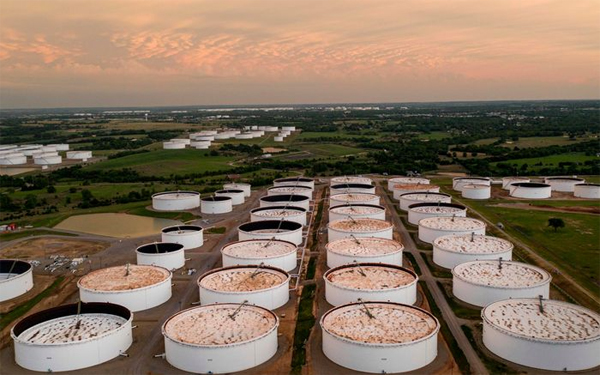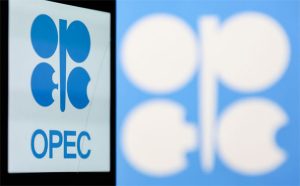Natural-gas prices fall by nearly 11%

Myra P. Saefong and William Watts, MarketWatch
SAN FRANCISCO/NEW YORK
EnergiesNet.com 01 05 2023
Oil futures finished higher on Thursday after suffering a two-day fall to begin 2023 on fears of a global economic slowdown and surging COVID cases in China.
Prices found support from news of a pipeline outage, as well as U.S. data showing a smaller-than-expected weekly rise in domestic crude inventories and declines in petroleum product stockpiles.
Price action
- West Texas Intermediate crude for February delivery CL00, -0.05% CL.1, -0.08% CLG23, -0.08% rose 83 cents, or 1.1%, to settle at $73.67 a barrel on the New York Mercantile Exchange.
- March Brent crude BRN00, -0.06% BRNH23, -0.10%, the global benchmark, climbed 85 cents, or 1.1%, at $78.69 a barrel on ICE Futures Europe
. - Back on Nymex, February gasoline RBG23, -0.47% rose nearly 0.4% to $2.2671 a gallon.
- February heating oil HOG23, -0.47% ended little changed at $2.9723 a gallon.
- February natural-gas futures NGG23, -2.18% dropped 10.8% to $3.72 per million British thermal units.
Market drivers
“Energy has seen a severe selloff recently and we would be surprised if further weakness does occur,” Tariq Zahir, managing member at Tyche Capital Advisors, told MarketWatch. “Charts on crude oil look bearish. However, we feel the risk is to the upside from here.”
On Thursday, crude-oil prices bounced higher after a two-day drop to begin 2023 saw both WTI and Brent fall more than 9%.
“It’s been a few decades since oil had this bad of a start [to a new year] and energy traders jumped all over the news that the Colonial Pipeline had to halt operations after a leak occurred,” said Edward Moya, senior market analyst at OANDA, in a market update. News reports said the pipeline operator had to shut its Line 3 pipeline for unscheduled maintenance.
“The shutdown should be over on Saturday, but the unexpected disruption helped oil prices stabilize,” said Moya.
Worries about the outlook for the global economy, and specifically China, have raised uncertainty about the outlook for energy demand.
“Chinese COVID infections are a concern for demand in the immediate term, however, the medium to long-term outlook is more constructive following the change in China’s COVID policy,” said Warren Patterson and Ewa Manthey, commodities strategists at ING, in a note.
“The oil market is looking better supplied in the near term and risks are likely skewed to the downside. However, our oil balance starts to show a tightening in the market from the second quarter through to the end of the year, which suggests that we should see stronger prices from 2Q23 onwards,” they wrote.
Supply data
Oil prices continued higher Thursday after the Energy Information Administration reported that U.S. crude inventories rose by 1.7 million barrels for the week ended Dec. 30.
On average, analysts forecasted a climb of 4.5 million barrels, according to a poll conducted by S&P Global Commodity Insights. The American Petroleum Institute said late Wednesday that U.S. crude inventories rose by 3.3 million barrels last week, sources said. Data were released a day later than usual this week due to Monday’s New Year’s holiday.
The EIA also showed weekly inventory declines of 300,000 barrels for gasoline and 1.4 million barrels for distillates. The S&P Global Commodity Insights survey had called for decreases of 1.6 million barrels for gasoline and 1.4 million barrels for distillates.
Crude stocks at the Cushing, Okla., Nymex delivery hub rose by 300,000 barrels for the week, the EIA said, while stocks in the Strategic Petroleum Reserve declined by 2.7 million barrels.
Natural-gas futures, meanwhile, lost more ground after the U.S. Energy Information Administration reported on Thursday that domestic natural-gas supplies fell by 221 billion cubic feet for the week ended Dec. 30. That was less than the average analyst forecast for a decline of 235 billion cubic feet, according to a survey conducted by S&P Global Commodity Insights.
Natural gas has been particularly volatile to start the year, but the tone has changed a bit, Colin Cieszynski, chief market strategist at SIA Wealth Management, told MarketWatch. Futures prices rose 4.6% on Wednesday after falling nearly 11% on Tuesday.
In 2022, “the main driver of natural gas came from the supply side, particularly related to sanctions,” said Cieszynski. “Toward the end of the year and particularly this week, the main driver of sentiment has shifted over to the demand side with the unusually warm temperatures in both North America and Europe reducing demand in what is typically the middle of home heating season.”
marketwatch.com 01 05 2022












